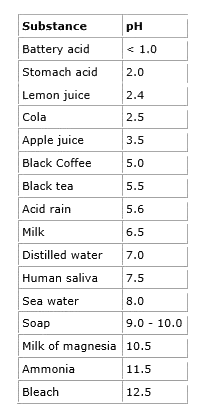Which of the following has pH is equal to near about one?
100mlM10HCl+100mlM10NaOH
55mlM10HCl+44mlM10NaOH
10mlM10HCl+90mlM10NaOH
75mlM10HCl+25mlM10NaOH
The correct Answer is:D
To determine which of the given solutions has a pH value near 1, we need to calculate the pH of each solution based on their concentrations and volumes. Let's break down the steps:
1. Identify the Solutions: We need to analyze the four solutions provided in the question. Let's assume they are:
- A: 100 mL of 0.1 M HCl
- B: 55 mL of 0.1 M HCl and 44 mL of 0.1 M NaOH
- C: 10 mL of 0.1 M HCl and 90 mL of 0.1 M NaOH
- D: 75 mL of 0.1 M HCl and 25 mL of 0.1 M NaOH
2. Calculate pH for Each Solution:
- Solution A:
- HCl is a strong acid and fully dissociates.
- Concentration of H⁺ = 0.1 M = 0.1 moles/L.
- pH = -log(H⁺) = -log(0.1) = 1.
- Solution B:
- H⁺ from HCl: 0.1 M × 55 mL = 5.5 mmoles.
- OH⁻ from NaOH: 0.1 M × 44 mL = 4.4 mmoles.
- Net H⁺ = 5.5 mmoles - 4.4 mmoles = 1.1 mmoles.
- Total volume = 55 mL + 44 mL = 99 mL.
- (H⁺) = 1.1 mmoles / 99 mL = 0.0111 M.
- pH = -log(0.0111) ≈ 1.95 (not near 1).
- Solution C:
- H⁺ from HCl: 0.1 M × 10 mL = 1 mmole.
- OH⁻ from NaOH: 0.1 M × 90 mL = 9 mmoles.
- Net OH⁻ = 9 mmoles - 1 mmole = 8 mmoles OH⁻.
- Total volume = 10 mL + 90 mL = 100 mL.
- (OH⁻) = 8 mmoles / 100 mL = 0.08 M.
- pOH = -log(0.08) ≈ 1.10, thus pH = 14 - 1.10 = 12.90 (not near 1).
- Solution D:
- H⁺ from HCl: 0.1 M × 75 mL = 7.5 mmoles.
- OH⁻ from NaOH: 0.1 M × 25 mL = 2.5 mmoles.
- Net H⁺ = 7.5 mmoles - 2.5 mmoles = 5 mmoles.
- Total volume = 75 mL + 25 mL = 100 mL.
- (H⁺) = 5 mmoles / 100 mL = 0.05 M.
- pH = -log(0.05) ≈ 1.30 (not near 1).
3. Conclusion:
- The only solution that has a pH value equal to near 1 is Solution A (100 mL of 0.1 M HCl).
Final Answer:
The solution with a pH value near 1 is Solution A (100 mL of 0.1 M HCl).
- A: 100 mL of 0.1 M HCl
- B: 55 mL of 0.1 M HCl and 44 mL of 0.1 M NaOH
- C: 10 mL of 0.1 M HCl and 90 mL of 0.1 M NaOH
- D: 75 mL of 0.1 M HCl and 25 mL of 0.1 M NaOH
- Solution A:
- HCl is a strong acid and fully dissociates.
- Concentration of H⁺ = 0.1 M = 0.1 moles/L.
- pH = -log(H⁺) = -log(0.1) = 1.
- Solution B:
- H⁺ from HCl: 0.1 M × 55 mL = 5.5 mmoles.
- OH⁻ from NaOH: 0.1 M × 44 mL = 4.4 mmoles.
- Net H⁺ = 5.5 mmoles - 4.4 mmoles = 1.1 mmoles.
- Total volume = 55 mL + 44 mL = 99 mL.
- (H⁺) = 1.1 mmoles / 99 mL = 0.0111 M.
- pH = -log(0.0111) ≈ 1.95 (not near 1).
- Solution C:
- H⁺ from HCl: 0.1 M × 10 mL = 1 mmole.
- OH⁻ from NaOH: 0.1 M × 90 mL = 9 mmoles.
- Net OH⁻ = 9 mmoles - 1 mmole = 8 mmoles OH⁻.
- Total volume = 10 mL + 90 mL = 100 mL.
- (OH⁻) = 8 mmoles / 100 mL = 0.08 M.
- pOH = -log(0.08) ≈ 1.10, thus pH = 14 - 1.10 = 12.90 (not near 1).
- Solution D:
- H⁺ from HCl: 0.1 M × 75 mL = 7.5 mmoles.
- OH⁻ from NaOH: 0.1 M × 25 mL = 2.5 mmoles.
- Net H⁺ = 7.5 mmoles - 2.5 mmoles = 5 mmoles.
- Total volume = 75 mL + 25 mL = 100 mL.
- (H⁺) = 5 mmoles / 100 mL = 0.05 M.
- pH = -log(0.05) ≈ 1.30 (not near 1).
- The only solution that has a pH value equal to near 1 is Solution A (100 mL of 0.1 M HCl).
The solution with a pH value near 1 is Solution A (100 mL of 0.1 M HCl).
Topper's Solved these Questions
- IONIC EQUILIBIUMBOOK - A2ZCHAPTER - IONIC EQUILIBIUMEXERCISE - Salt Hydrolysis
36 Videos
- IONIC EQUILIBIUMBOOK - A2ZCHAPTER - IONIC EQUILIBIUMEXERCISE - Common Ion Effect, Ksp And Applications
38 Videos
- IONIC EQUILIBIUMBOOK - A2ZCHAPTER - IONIC EQUILIBIUMEXERCISE - Section D - Chapter End Test
30 Videos
- HYDROGENBOOK - A2ZCHAPTER - HYDROGENEXERCISE - Section D - Chapter End Test
30 Videos
- MOCK TESTBOOK - A2ZCHAPTER - MOCK TESTEXERCISE - Mock Test 2
45 Videos
Similar Questions
Knowledge Check
Which of the following has highest pH?
AHuman salivaBHuman bloodCGastric juiceDUrineWhich of the following has highest pH ?
AM4KOHBM4NaOHCM4NH4OHDM4Ca(OH)2Which of the following has maximum pH ?
A1 N CH3COOHB1N HClC1 N H2SO4D1 N HNO3
Which of the following has minimum pH?
View SolutionWhich of the following has the highest pH
View SolutionThe pH values of many common liquids are given in the table below.

Study the table and answer the questions that follow.
Amit has black coffee with milk.
Which of the following is most likely to be true about the pH of the mixture?
View SolutionpH value of which one of the following is not equal to one?
View SolutionWhich of the following has the minimum pH ?
View Solution
